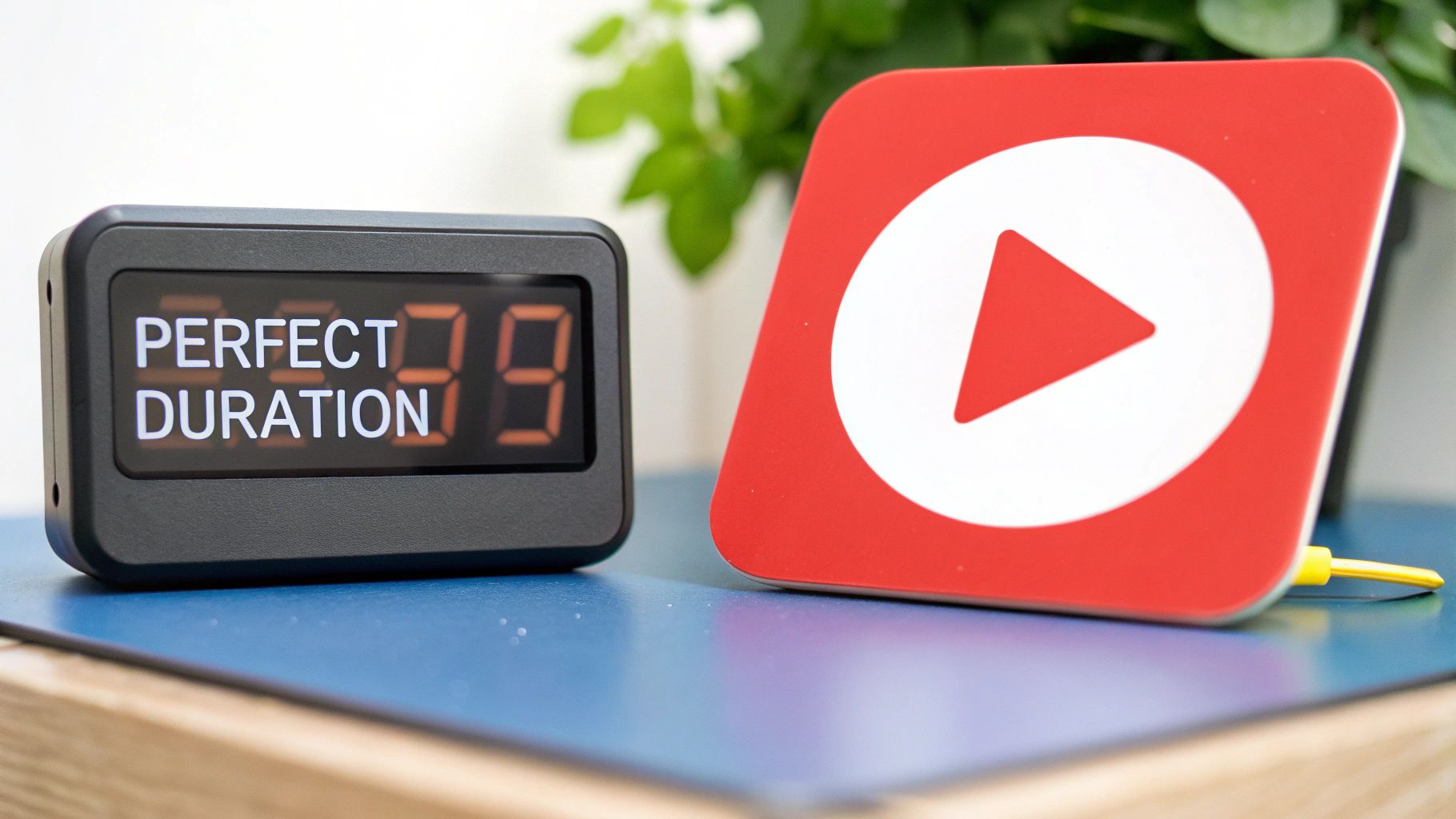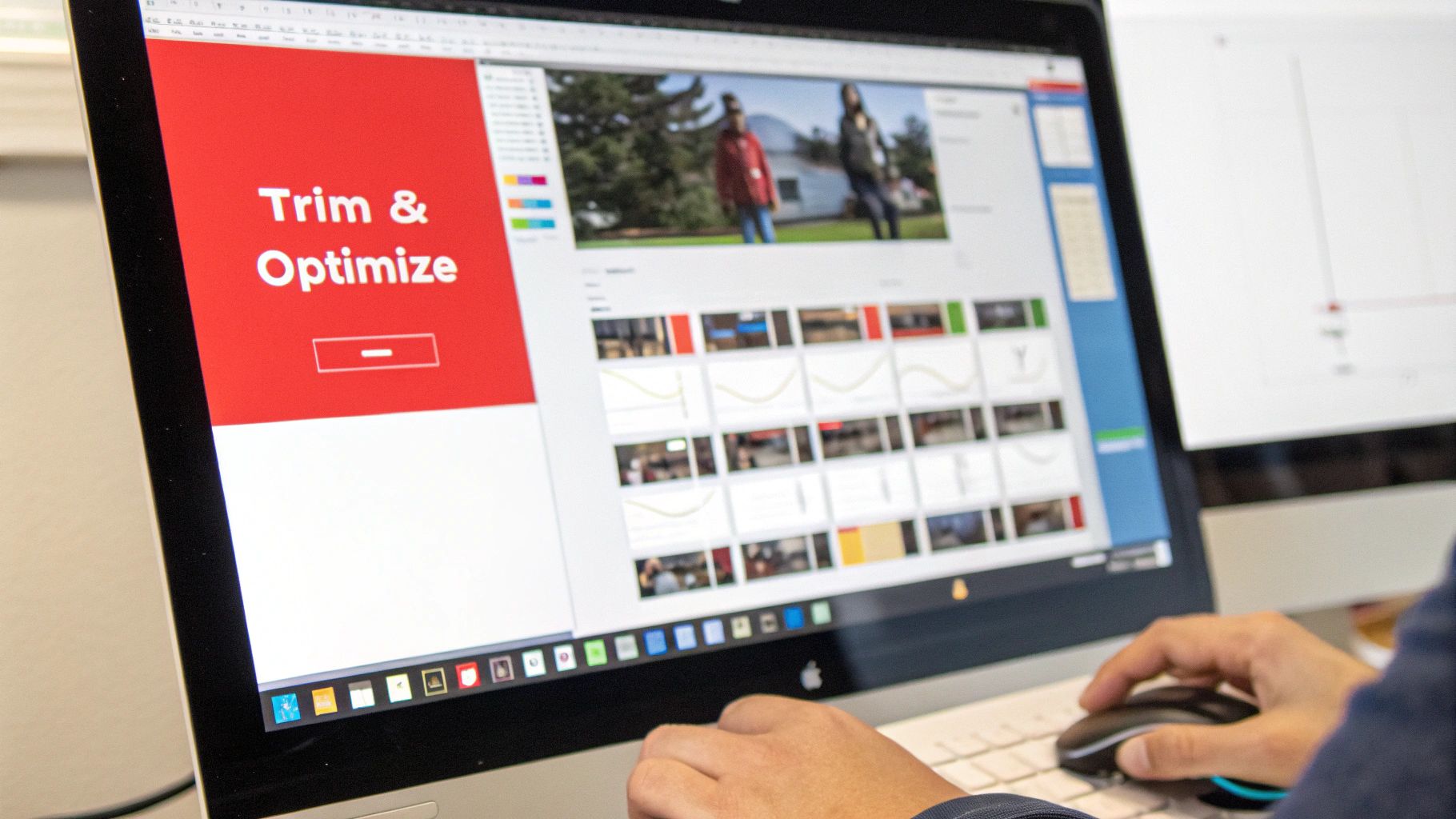Why Video Length Is Your Critical Strategic Advantage
The ideal length for a YouTube video isn't a universal standard; it's a strategic opportunity. How long your video is directly affects how the YouTube algorithm ranks your content, how viewers interact with it, and ultimately, your channel's growth. It's not about aiming for a magic number; it's about understanding viewer behavior and working with the platform's reward system.
Understanding Viewer Psychology and Platform Rewards
Think of video length as a conversation. A short video is like a quick hello, ideal for a brief message. A longer video is like an in-depth discussion, providing space for detailed explanations and complex narratives. Both are valuable, but knowing when to use each is crucial. YouTube favors videos that hold viewers' attention. Longer watch times tell the algorithm that your content is worthwhile, resulting in greater visibility and more recommendations.
However, longer videos demand more from your audience. You need to grab their attention quickly and consistently deliver value to keep them engaged. This is where the strategy of video length comes into play. Understanding typical blog post lengths can offer helpful context for video duration. Check out this guide on how long a blog post should be. Comparing the two can help you understand content consumption across different mediums.
The Power of the 7-15 Minute Range
Research suggests that videos between 7 and 15 minutes often hit the sweet spot for viewer engagement. This range typically provides significant value while respecting the viewer's time. But this doesn't mean other lengths can't be effective. Longer videos, especially those over 30 minutes, are growing in popularity as viewers increasingly use YouTube for in-depth learning. Shorter videos, particularly under 7 minutes, excel at quick tips, news updates, or viral-style content. YouTube's policy, allowing verified accounts to upload videos up to 12 hours long (though most creators stick to much shorter formats), highlights this flexibility. Learn more about ideal video length here.
Adapting to Platform Evolution
YouTube is always changing, meaning the ideal video length can also shift. Algorithm updates, evolving user behavior, and new features all play a role in what performs best. Keeping up with these changes and adapting your strategy is vital for long-term success. By analyzing platform trends and trying different video lengths, you can refine your approach and consistently create engaging content that resonates with your audience. This constant optimization ensures your videos remain discoverable and effective on the ever-changing YouTube platform.
The 7-15 Minute Sweet Spot: Why It Consistently Delivers

Video length plays a significant role in YouTube success. So, what's the best length for a YouTube video? While different lengths can work, the 7-15 minute range is a sweet spot for many creators. This isn't arbitrary; it balances viewer psychology and the YouTube algorithm.
Balancing Depth and Accessibility
Seven to fifteen minutes gives creators time to dive into a topic and provide real value. It's enough time for detailed explanations, engaging stories, and demonstrating complex ideas. But, it's also short enough that it doesn't feel like a huge time commitment for viewers, minimizing viewer commitment anxiety and encouraging more clicks.
This timeframe allows for richer content while remaining accessible. Viewers get valuable insights without feeling overwhelmed by an overly long video. This delicate balance is key to attracting and retaining viewers.
Algorithmic Preference and Monetization
The 7-15 minute range aligns well with the YouTube algorithm, which prioritizes watch time. Longer videos, if they keep viewers engaged, boost overall watch time. This signals value to YouTube, leading to higher rankings and more visibility. Plus, this length allows for more mid-roll ads, potentially boosting revenue for creators using MonetizedProfiles.
Longer watch times translate to increased visibility. The algorithm recognizes engaging content and rewards it with better placement in search results and recommendations. This organic reach is vital for channel growth.
Structuring for Success Within the Sweet Spot
Successful YouTubers structure their videos within this 7-15 minute timeframe strategically.
- Compelling Introductions: Hook viewers instantly to prevent early drop-off.
- Pacing and Engagement: Keep a dynamic pace with diverse content, visuals, and calls to action.
- Value Delivery: Continuously provide valuable information, entertainment, or insights.
- Strong Conclusions: End with a clear takeaway and encourage further engagement.
These elements work together to create a compelling viewing experience. By capturing attention early, maintaining engagement, and delivering value, creators can maximize the impact of their videos.
Let's take a look at how engagement metrics typically vary across different video lengths. The following table offers insights into this relationship:
Engagement Metrics by Video Length
This table shows how key engagement metrics vary across different video length ranges
| Video Length | Average Watch Time | Retention Rate | Comment Rate | Recommended Video Rate |
|---|---|---|---|---|
| < 5 minutes | 2:30 | 60% | 0.5% | 2% |
| 5-7 minutes | 4:00 | 65% | 0.7% | 3% |
| 7-15 minutes | 8:00 | 75% | 1.0% | 5% |
| 15-20 minutes | 10:00 | 70% | 1.2% | 4% |
| > 20 minutes | 12:00 | 60% | 1.5% | 3% |
As you can see, videos in the 7-15 minute range often achieve the highest retention rates and recommended video rates, demonstrating the effectiveness of this sweet spot.
Beyond the Sweet Spot: Strategic Deviations
While 7-15 minutes is a good starting point, it's not a strict rule. Shorter videos are great for quick tips or viral moments. A short tutorial on a trending topic can take off quickly. Longer videos suit in-depth discussions, tutorials, or documentaries, especially if your audience likes long-form content. Understand your audience and content, and experiment to find what performs best. This targeted approach maximizes your videos' potential, regardless of length.
Platform Evolution: How YouTube's Transformation Affects Length

YouTube has changed dramatically since it first launched. It's no longer just a place for funny animal videos. Now it’s a diverse platform with all kinds of content, from short-form Shorts to hours-long live streams. This evolution has greatly affected the ideal length for YouTube videos.
The Shift From Short-Form to Long-Form
In the early days of YouTube, shorter videos were king. Limited bandwidth and shorter attention spans meant viewers preferred quick, digestible content.
However, as technology and viewing habits changed, so did YouTube. Faster internet speeds and the increase in mobile viewing paved the way for longer videos.
This shift allowed creators to make in-depth tutorials, documentaries, and let's plays. This fundamentally changed the optimal length for a successful YouTube video strategy.
For example, the introduction of monetization features encouraged creators to make longer videos. Longer videos meant more ad placements. This led to higher production quality and more detailed content. The average video length started to grow beyond the initial short-form format. You might be interested in: How to master YouTube.
Algorithm Updates and Viewer Habits
YouTube's algorithm is constantly changing. This has a big impact on which videos get recommended and rank well in search results. Initially, the algorithm focused on click-through rates.
However, over time, watch time became a key metric. This change encouraged creators to make longer videos to keep viewers engaged and increase watch time.
Viewer habits have also changed. People now use YouTube for many different reasons, including education, entertainment, and even as a replacement for traditional television.
This variety of uses has created a wider range of acceptable video lengths. This makes it more important than ever to tailor content to a specific audience. In 2021, YouTube hosted about 2.7 billion videos. This number more than doubled to over 5 billion by 2025.
With 360 hours of video uploaded every minute, understanding the average video length (around 12 minutes) is important for standing out. Find more statistics here.
Adapting to the Changing Landscape
The best length for a YouTube video isn't fixed. It changes based on platform updates and audience preferences. Creators need to keep up with algorithm updates, study their audience demographics, and try out different video lengths.
Being adaptable is essential for success in online video. By understanding how YouTube has evolved, creators can improve their content’s visibility and engagement. This proactive strategy helps channels stay relevant and continue growing as the platform changes.
Content Category Duration Mastery: Finding Your Perfect Length
While the 7-15 minute range is a good starting point for video length, different types of content perform best at different lengths. A one-size-fits-all approach won't work. To really optimize your video length, think about the specific type of content you're creating and what your audience expects. For example, a product review will likely have a different ideal length than a video game walkthrough.
Understanding Category-Specific Expectations
Viewers have different expectations about video length depending on the type of content. Tutorials often benefit from being short and to the point, delivering information quickly. Vlogs and other entertainment content can be longer, allowing creators to connect with viewers on a deeper level. Educational videos on complex topics might need more time to fully cover the subject matter.
YouTube itself changes, too. The rise of YouTube Shorts has had a major impact on video length strategy. Adapting to platform and category changes is essential for success.
Matching Length to Content Type
Gaming videos are a good example of how length can vary within one category. Let's plays, where creators record themselves playing a game, often do well at 45+ minutes. This provides an immersive experience for viewers who enjoy extended gameplay and commentary. On the other hand, game review videos tend to perform better around 12 minutes, offering a concise overview of the game.
To help illustrate ideal video lengths across different content types, we've put together a helpful table:
To help you choose the ideal length for your videos, we've compiled a table showing recommended durations for various content types.
Optimal Video Length by Content Type This comparison table shows recommended video lengths based on different content categories.
| Content Type | Ideal Length Range | Minimum Effective Length | Maximum Recommended Length | Key Considerations |
|---|---|---|---|---|
| Explainer Videos | 1-3 minutes | 30 seconds | 5 minutes | Keep it concise and engaging. |
| Product Reviews | 2-5 minutes | 1 minute | 10 minutes | Balance detail with conciseness. |
| Tutorials | 5-10 minutes | 2 minutes | 20 minutes | Break down complex tasks into digestible steps. |
| Vlogs | 5-15 minutes | 3 minutes | 30 minutes | Foster connection and authenticity. |
| Gaming Let's Plays | 15-60+ minutes | 10 minutes | No strict maximum | Cater to audience expectations for extended gameplay. |
| Educational Content | 10-20 minutes | 5 minutes | 30+ minutes | Provide in-depth explanations and examples. |
| Comedy Sketches | 1-5 minutes | 30 seconds | 10 minutes | Deliver quick, impactful humor. |
Remember these are just guidelines. It’s always important to test and see what works best for your specific audience. Experimenting with different video lengths is key to finding the sweet spot for your channel.
Analyzing Top Performers and Competitive Landscape
One of the best ways to find the right video length for your category is to analyze the top channels in your niche. Looking at what successful creators are doing can give you valuable insights into what your target audience likes. This competitive analysis can also reveal trends and changes in viewer preferences, allowing you to stay ahead of the curve.

As the data shows, videos in the 4-6 minute range retain viewers at the highest rate (60%), with a noticeable drop as videos get longer. This reinforces the need to match your video length to what viewers expect.
Also, think about the specific needs of different entertainment formats like comedy sketches or music videos. These often benefit from shorter presentations to keep viewers engaged. Understanding these nuances is crucial for choosing the right length for your YouTube videos. By understanding the connection between video length and content type, you can create videos that have the greatest impact and reach.
Beyond Duration: Retention Tactics That Keep Viewers Watching
The perfect length for a YouTube video is only half the battle. Even if your video hits that "ideal" length, viewers won't stick around if the content isn't engaging. This section explores tactics successful creators use to keep viewers hooked from beginning to end, no matter the video's duration.
The Art of the Irresistible Opening
The first few seconds of your video are crucial for grabbing a viewer's attention. You need to instantly make them want to keep watching. This is where a compelling hook comes in. Think of it as a movie's opening scene: it sets the stage and creates intrigue.
-
Start with a question: Pose a question related to your video’s topic to immediately pique viewers' curiosity.
-
Showcase a highlight: Offer a sneak peek of the most exciting or valuable part of the video.
-
Use a surprising statistic: A shocking fact or statistic can be a powerful way to draw viewers in.
These tactics create a reason for viewers to stay engaged. A strong opening sets the tone and significantly impacts retention rates.
Maintaining Momentum: Pattern Interrupts and Pacing
Even the best opening won't save a video with poor pacing. Pattern interrupts are essential for keeping viewers engaged. These are small changes in the video's rhythm that prevent viewer fatigue.
-
Visual Variety: Switch between different camera angles, use B-roll footage, and incorporate graphics.
-
Audio Shifts: Vary the music, add sound effects, or change your speaking tone.
-
Content Breaks: Use quizzes, polls, or short stories to break up the main content and offer engaging pauses.
Just like a good book needs varied sentence structure, a YouTube video needs pacing variations to hold viewers' interest.
Crafting a Narrative: Keeping Viewers Invested
Treat your video like a story. It should have a beginning, middle, and end, with a clear narrative arc. This structure builds anticipation and provides a satisfying payoff for the viewer.
-
Establish a clear objective: Tell viewers what they will learn or gain by watching your video.
-
Build suspense: Tease the solution or the climax of your video to create anticipation.
-
End with a call to action: Encourage viewers to like, comment, subscribe, or check out other content.
A well-crafted narrative transforms a simple video into a more compelling viewing experience.
Editing for Retention: Eliminating Drop-Off Points
Strategic editing is key to maintaining high retention. Analyzing your video analytics in YouTube Studio can reveal where viewers tend to drop off. Common drop-off points include long introductions, repetitive content, or slow pacing. Learn more in our article about How to master YouTube.
-
Trim unnecessary content: Cut out any fluff or tangents that don't add value to the video.
-
Tighten transitions: Ensure a smooth, logical flow between different segments.
-
Add visual cues: Use text overlays, animations, or zoom effects to highlight important information.
Addressing these common issues can significantly improve viewer retention and maximize your content’s impact. These retention strategies, combined with finding the right video length, are crucial for creating engaging and successful YouTube content.
Testing Your Perfect Length: Data-Driven Optimization Framework

Finding the ideal length for your YouTube videos is a bit more complex than just following general rules. It actually requires a data-driven approach tailored to your specific channel and audience. This means ditching the guesswork and building a solid testing framework. This section will walk you through a proven system used by data-focused creators to identify their optimal video length.
Establishing Baseline Metrics
Before you start playing around with different lengths, you need a good understanding of your current video performance. This starts with establishing baseline metrics in YouTube Analytics.
- Average View Duration: This tells you how much of your videos people are actually watching.
- Audience Retention: This metric pinpoints exactly where viewers start to drop off.
- Click-Through Rate: This shows how compelling your video thumbnails and titles are in search results and suggested videos.
These baseline metrics serve as your starting point. They're the benchmark against which you'll measure the impact of any length adjustments. This data-driven foundation is essential for making informed decisions about your content strategy.
Designing Controlled Length Experiments
The next stage is all about designing controlled experiments. This involves isolating the variable of video length to see its true impact.
- Create Similar Videos: Make videos on the same topic with a similar style, but vary the length. For instance, try creating one 7-minute video, one 12-minute video, and one 17-minute video.
- Consistent Promotion: Promote each video equally across your social media channels and other platforms. This ensures a fair comparison.
- Track Metrics: Closely monitor those key metrics we talked about earlier: average view duration, audience retention, and click-through rate.
By keeping other variables consistent, you can clearly see how video length affects your performance.
Interpreting Retention Signals
YouTube Analytics offers powerful retention data which reveals precisely where viewers lose interest. This information is invaluable for optimizing your content, regardless of the total length. If you notice a consistent drop-off point, it could indicate an issue with the pacing or the content itself at that particular moment. Fixing that problem could significantly boost your video’s overall performance.
Understanding viewer behavior helps you identify areas for improvement and boost engagement.
Segmenting Your Findings
Don't just look at the overall data. Break down your findings by content subcategories, traffic sources, and audience demographics. You might find that videos on certain topics perform better at a different length than others. Viewers coming from different sources (like search, suggested videos, or social media) might also have different expectations for video length. This detailed analysis can uncover hidden optimization opportunities you’d otherwise miss.
This granular approach gives you valuable insights into what resonates most with different viewer segments. By tailoring your length strategy accordingly, you create a better viewing experience and maximize your reach.
Building Your Data-Driven Duration Strategy
By putting all these insights together, you can create a video length strategy perfectly suited to your audience and content niches. This dynamic approach lets you adapt to changes in platform trends and viewer preferences.
Want to jumpstart your YouTube channel’s growth? MonetizedProfiles offers monetization-approved YouTube accounts to help you get started. Check them out today!








